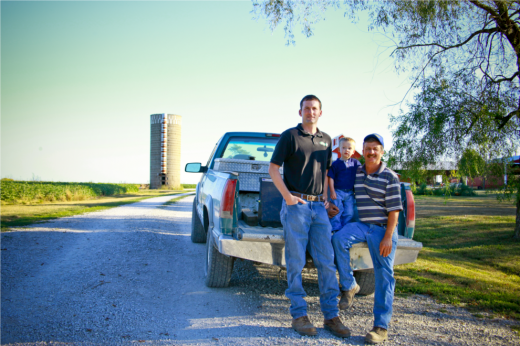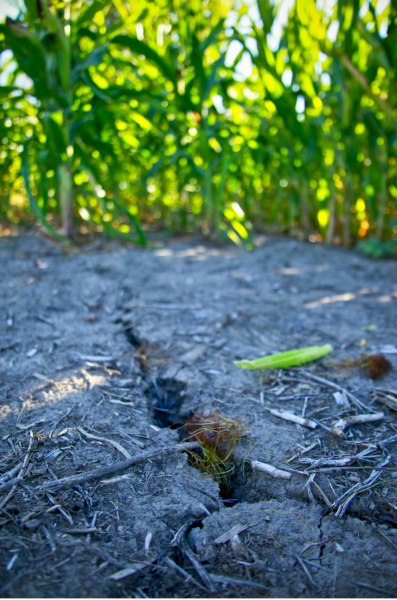Do No Harm

As the drought continued in August across 78 percent of the United States, the USDA rated all of Missouri’s fields at least severe and nearly all of the state’s grazing pastures at least poor. The grim struggle leaves local farmers such as Brett Shryock with the question of what to do with their crops: wait until harvest time in October and hope for a miracle or cut them for silage as feed for cattle.
In August, the USDA projected that the upcoming U.S. corn harvest will produce 10.8 billion bushels, the lowest yield in 17 years, according to Peter Zimmel, program director for representative farms at the Food and Agricultural Policy Research Institute. Likewise, soybean predictions of 36.1 bushels per acre mark the lowest yield since 2003.
In late August, the World Bank reported that food prices climbed 10 percent from June to July. According to Tom Zacharias, president of National Crop Insurance Services, low crop yields should concern everybody because we all eat.
“Everyone should have a vested interest in safe and stable agriculture,” he says. The U.S. spends less per capita on food than any other nation, and Zacharias says that trend depends on the success of American farmers.
Insuring production
To encourage farmers to produce plenty of food, the federal government subsidizes farmers’ insurance premiums up to 60 percent. Individual states, however, can pay higher percentages depending upon the level of farmer participation.
The U.S. government also reinsures crop insurance providers and covers the loss when crop insurance companies pay out more than $1 in claims for every $1 in premiums, says Ray Massey, agricultural economics professor at the University of Missouri. For example, if an insurance company pays $1.50 more in claims than it receives in premiums, it pays 8 cents to farmers, and the government pays $1.42, Massey says.
For both producer subsidies and repayment to crop insurance companies, the government spent $9 billion this past spring, according to The Washington Post.

In Missouri, there are 10 companies that provide crop insurance, says Angela Nelson, the division director of market regulation for the Missouri Department of Insurance. The state’s three largest sellers are Farmers Mutual Insurance Co. of Iowa, with 56 percent market share; Great American, with 15 percent; and AgriGeneral, with 13 percent.
A recent report from Moody’s Investment Service suggests that crop insurers could face their first overall loss in 10 years. Although the insurance industry will face this financial blow, farmers might be able to skirt a similar hit and plant again next year. Luckily, almost 90 percent of Missouri’s corn acreage is insured, Massey says.
“Insurance is always worthwhile for those who want to protect themselves against loss to their property or financial loss, and the degree by which any person chooses to insure their property or their financial livelihood is really an individual decision that they would have to make,” he says.
Yield vs. revenue
In the spring, farmers can either insure their crop’s yield or their revenue. Last year, the average yield protection insurance premium cost $16.51 an acre, while revenue protection cost $27.14, though the price varies based on location, history and the level of insurance purchased, Zimmel says.

The difference: Yield protection pays according to the government-calculated average March 1 price, which for corn was $5.68 a bushel, but revenue protection insurance pays the price at harvest time, which rose 50 percent during the summer to $8.30 a bushel on Aug. 24.
“If the price through September holds at about $8, where it’s at right now, people who were expecting insurance at $5.68 are going to get insurance at $8,” Massey says. “So those guys are going to make a lot of money.”
Although insurance companies cap the revenue-protected price at $11.36 per bushel, which is double the March 1 price, even at the current price of $8.30, the farmer would receive $539,500 in insurance, while those who purchased yield protection would only receive $369,200. Depending on the percentage of the crop insured and weighed against potential production costs of $600 an acre, the farmer may lose money, break even or show a large profit, according to Shryock.
Zacharias sees the situation a bit differently. Although some farmers able to harvest a reasonable crop will make a decent amount of money as prices for crops continue to increase, the majority of farmers won’t profit from insurance indemnities.
It’s a gamble. When farmers purchase crop insurance, they usually insure a percentage of their average yield, based on the previous 10 years of crops, Shryock says. Crop insurance pays the difference between what is actually harvested and the percentage insured.
For a hypothetical farmer who purchased revenue-protected crop insurance for 75 percent of his or her 1,000-acre farm, which has averaged 140 bushels an acre in the past, insurance would therefore cover 105 bushels an acre. In a normal year, there’s no claim. But this year at harvest time, the yield is only 40 bushels an acre, so the insurance company pays the difference of 65 bushels an acre.
With private sector involvement sharing the risk with the government, a high level of farmer participation and no demands for supplemental disaster programs as there have been in the past, Zacharias says the program is working as designed.
“The aim is straightforward: Do no harm,” Zacharias says. “By that standard, the program is doing what it’s designed to do.”


